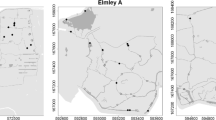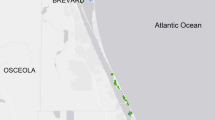Abstract
A model of the mosquito–mangrove basin ecosystem is presented detailing the habitat of the saltwater mosquito Aedes vigilax utilizing mangrove basin forests in Australia. The modeling included a synthesis of empirical observations and published descriptions including the insect’s relevant life-stages, mangrove basin topography and hydrodynamics. Shallow mangrove basins periodically connected by only the highest 10% of high tides with a hummocky substrate micro-topography characterize the main mangrove form conducive to Ae. vigilax breeding. Other essential features include the synchronization of the mosquito’s lifecycle to basin hydrodynamics and thus an intricate relationship between hydrodynamics and basin structure. Very small decreases in basin water level (~1 cm/day) lead to significant decreases in extent of standing water (for example, 60% over 6 days) across the basin. This results in corresponding increases in the extent of exposed substrate. Also, the modeling demonstrated sensitivity of the mosquito–mangrove basin ecosystem to sea level changes. A hydrologic model of the basin was used to predict mosquito breeding episodes which were tested against a mosquito management larviciding program. The model predicted 75% of all 29 larviciding treatments undertaken. Comparing the model against the two triggers used by mosquito control, tides and rainfall, the model predicted 92% of tidally instigated treatments and 60% of rainfall instigated treatments. Application of the model enables consideration of environment-based minimal habitat modification for mosquito control in mangroves, not previously possible. The model will be applicable to similar species, such as Ae. taeniorhynchus, found in Florida’s (USA) mangroves.







Similar content being viewed by others
References
AAMHatch. 2007. CCC2007 Digital Terrain Model Upgrade: Data Documentation, Volume 12552A01NOP. Perth: AAMHatch Pty Ltd. pp 1–12.
Addison DS, Ritchie SA, Webber LA, van Essen F. 1992. Eggshells as an index of Aedine mosquito production 2: relationship of Aedes taeniorhynchus eggshell density to larval production. J Am Mosquito Control Assoc 8(1):38–43.
Anon. 2010. Queensland tide tables 2010, Maritime Safety Queensland, Brisbane, 176 p.
Arthington AH, Marshall CJ. 1999. Diet of the exotic mosquitofish, Gambusia holbrooki, in an Australian lake and potential for competition with indigenous fish species. Asian Fish Sci 12(1):1–16.
Carlson DB. 2006. Source reduction in Florida’s salt marshes: management to reduce pesticide use and enhance the resource. J Am Mosquito Control Assoc 22(3):534–7.
Clements AN. 1992. The biology of mosquitoes. London (UK): Chapman and Hall. 509 p.
Dale PER. 2008. Assessing impacts of habitat modification on a subtropical salt marsh: 20 years of monitoring. Wetlands Ecol Manage 16:77–87.
Dale PER, Hulsman K, Harrison D, Congdon B. 1986. Distribution of the immature stages of Aedes vigilax on a coastal salt-marsh in south-east Queensland. Aust J Ecol 11:269–78.
Dale PER, Knight J, Kay BH, Chapman H, Ritchie SA, Brown MD. 2008. Habitat characteristics and eggshell distribution of the salt marsh mosquito, Aedes vigilax, in marshes in subtropical eastern Australia. J Insect Sci 8(25):8.
ESRI. 2010. ArcGIS version 10. http://www.esri.com/.
Gislason GM, Russell RC. 1997. Oviposition sites of the saltmarsh mosquito, Aedes vigilax (Skuse) (Diptera: Culicidae), at Homebush Bay, Sydney, NSW—a preliminary investigation. Aust J Entomol 36:97–100.
Griffin LF, Knight JM, Dale PER. 2010. Identifying mosquito habitat micro-topography in an Australian mangrove forest using LiDAR derived elevation data. Wetlands 30:929–37.
Hugo LE, Kay BH, Ryan PA. 2003. Autogeny in Ochlerotatus vigilax (Diptera: Culicidae) from Southeast Queensland, Australia. J Med Entomol 40(6):897–902.
Hulsman K, Dale PER, Kay BH. 1989. The runnelling method of habitat modification—an environment-focused tool for salt-marsh mosquito management. J Am Mosquito Control Assoc 5(2):226–34.
Jeffery JAL, Kay BH, Ryan PA. 2005. Development time and survival of Verrallina funerea (Theobald) (Diptera: Culicidae) immatures and other brackish water mosquito species in southeast Queensland, Australia. Aust J Entomol 44(3):226–32.
Judson CL. 1960. The physiology of hatching of Aedine mosquito eggs: hatching stimulus. Ann Entomol Soc Am 53:688–91.
Kay BH, Jorgensen WK. 1986. Eggs of Aedes vigilax (Skuse) and their distribution on plants and soil in southeast Queensland saltmarsh. J Aust Entomol Soc 25:267–72.
Knight JM, Dale PER, Phinn SR. 2005. Ochlerotatus vigilax breeding within mangrove basin forests: information requirements for remote sensing. Arbovirus Res Aust 9:179–83.
Knight JM, Dale PER, Dunn RJK, Broadbent GJ, Lemckert CJ. 2008. Patterns of tidal flooding within a mangrove forest: Coombabah Lake, Southeast Queensland, Australia. Estuarine. Coast Shelf Sci 76(3):580–93.
Knight JM, Dale PER, Spencer J, Griffin L. 2009. Exploring LiDAR data for mapping the micro-topography and tidal hydro-dynamics of mangrove systems: an example from southeast Queensland, Australia. Estuarine. Coast Shelf Sci 85(4):593–600.
Knight JM, Griffin LF, Dale PER, Phinn SR. in press. Oviposition and larval habitat preferences of the saltwater mosquito, Aedes vigilax, in a subtropical mangrove forest in Queensland, Australia. J Insect Sci.
Kokkinn MJ, Duval DJ, Williams CR. 2009. Modeling the ecology of the coastal mosquitoes Aedes vigilax and Aedes camptorhynchus at Port Pirie, South Australia. Med Vet Entomol 23(1):85–91.
Kumar R, Hwang JS. 2006. Larvicidal efficiency of aquatic predators: a perspective for mosquito biocontrol. Zool Stud 45(4):447–66.
Lee DJ, Hicks MM, Griffiths M, Russell RC, Marks EN, Eds. 1984. The Culicidae of the Australasian region. Monograph Series: Entomology Monograph No. 2. Canberra (Aus), Australian Government Publishing Service.
Marks EN. 1968. Annual report of the national mosquito control committee 1967–68. Appendix, Annual report. Brisbane: Health and Medical Services, Queensland. pp 97–8.
Morton MM, Beumer JP, Pollock BR. 1988. Fishes of a subtropical Australian saltmarsh and their predation upon mosquitoes. Environ Biol Fish 21(3):185–94.
Nielsen ET, Evans DG. 1960. Duration of the pupal stage of Aedes taeniorhynchus with a discussion of the velocity of development as a function of temperature. Oikos 11(2):200–22.
Ritchie SA. 1984. Record winter rains and the minimal populations of Aedes taeniorhynchus (Wiedemann): cause and effect? J Fla Anti-Mosquito Assoc 55(1):14–21.
Ritchie SA. 1990. A simulation model of water depth in mangrove basin forests. J Am Mosquito Control Assoc 6(2):213–22.
Ritchie SA. 1993. Aedes vigilax: the taeni of Oz. Arbovirus Res Aust 6:52–8.
Ritchie SA. 1994. Spatial stability of Aedes vigilax (Diptera, Culicidae) eggshells in Southeastern Queensland salt marshes. J Med Entomol 31(6):920–2.
Ritchie SA, Addison DS. 1991. Collection and separation of Aedes taeniorhynchus eggshells from mangrove soils. J Am Mosquito Control Assoc 7(1):113–15.
Ritchie SA, Addison DS. 1992. Oviposition preferences of Aedes taeniorhynchus (Diptera: Culicidae) in Florida mangrove forests. Environ Entomol 21(4):737–44.
Ritchie SA, Jennings CD. 1994. The dispersal and sampling of Aedes vigilax eggshells in south-east Queensland, Australia. J Am Mosquito Control Assoc 10:181–5.
Ritchie SA, Johnson ES. 1991. Aedes taeniorhynchus (Diptera: Culicidae) oviposition patterns in a Florida mangrove forest. J Med Entomol 28:496–500.
Ritchie S, Laidlaw-Bell C. 1994. Do fish repel oviposition by Aedes taeniorhynchus? J Am Mosquito Control Assoc 10(3):380–4.
Ritchie SA, Montague CL. 1995. Simulated populations of the black salt marsh mosquito (Aedes taeniorhynchus) in a Florida mangrove forest. Ecol Model 77(2–3):123–41.
Ritchie S, Addison D, van Essen F. 1992. Eggshells as an index of aedine mosquito production 1: distribution, movement and sampling of Aedes taeniorhynchus eggshells. J Am Mosquito Control Assoc 8(1):32–7.
Russell RC. 1998. Mosquito-borne arboviruses in Australia: the current scene and implications of climate change for human health. Int J Parasitol 28(6):955–69.
Sinclair P. 1976. Notes on the biology of the salt-marsh mosquito, Aedes vigilax (Skuse) in South-east Queensland. Qld Nat 25(5–6):134–9.
Vensim 2010. Vensim PLE for Windows, Version 5.10e. http://www.vensim.com/.
Woodward DB, Chapman HC. 1970. Hatching of floodwater mosquitoes in screened and unscreened enclosures exposed to natural flooding of Louisiana salt marshes. Mosquito News 30:545–50.
Acknowledgments
I thank the reviewers for their useful comments and suggestions. I thank John Spencer (Griffith University) and Nicole Shepherd for reviewing the revised manuscript. I acknowledge support from and thank: Professor Pat Dale (Griffith University) for comments and suggestions throughout the work; Cecily Draper, Program Leader Pest Management at Moreton Bay Regional Council, and Clive Easton, Entomologist, Tweed Shire Council, for comments and improvements on the various model components; Professor Stuart Phinn and staff in the School of Geography Planning and Environmental Management, University of Queensland, for supporting and resourcing when conducting some of the early research; and, the Coastal Zone, Estuary and Waterway Management CRC and the Australian Government who provided financial support to undertake some of the early research. I also thank: Daryl Metters, Spatial Information Manager, Tidal Unit, Maritime Safety Queensland Tidal for providing tidal observation data and high tide exceedance data; the Australian Bureau of Meteorology for providing rainfall and weather data; and, the Mosquito and Arbovirus Research Committee for on-going support.
Author information
Authors and Affiliations
Corresponding author
Rights and permissions
About this article
Cite this article
Knight, J.M. A Model of Mosquito–Mangrove Basin Ecosystems with Implications for Management. Ecosystems 14, 1382–1395 (2011). https://doi.org/10.1007/s10021-011-9487-x
Received:
Accepted:
Published:
Issue Date:
DOI: https://doi.org/10.1007/s10021-011-9487-x




